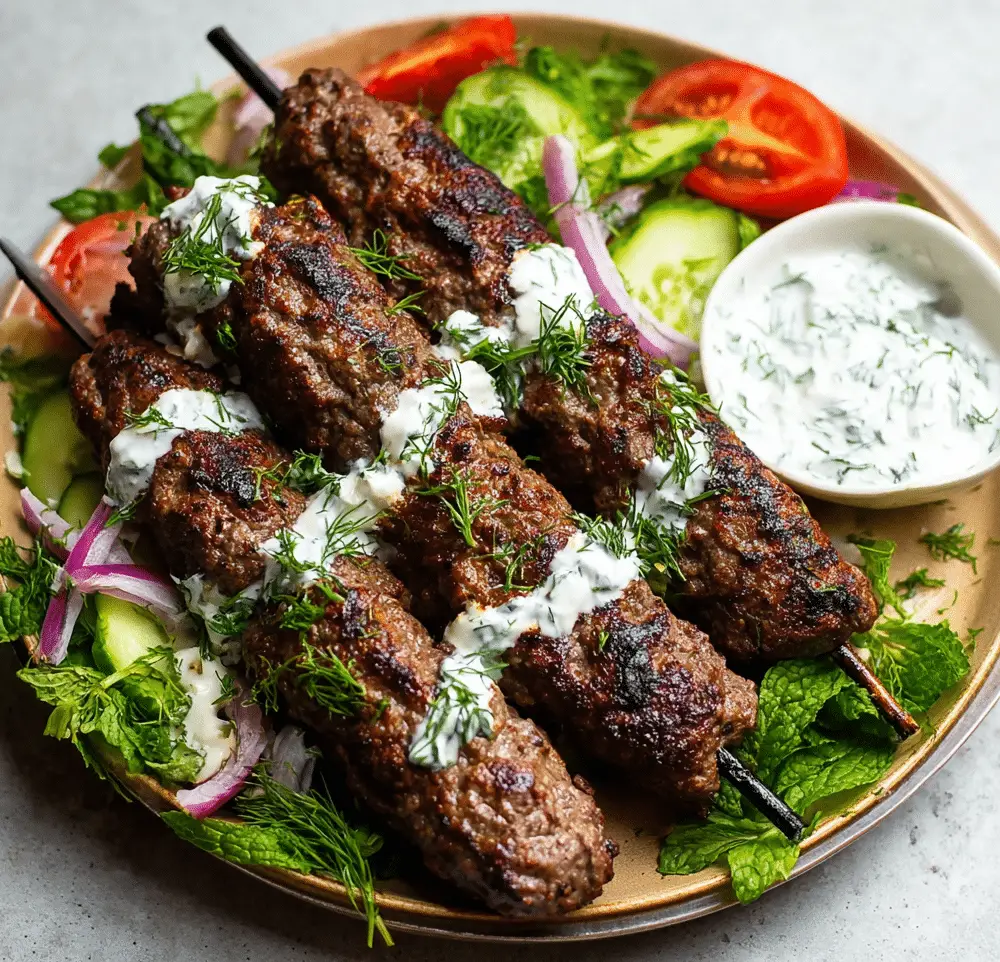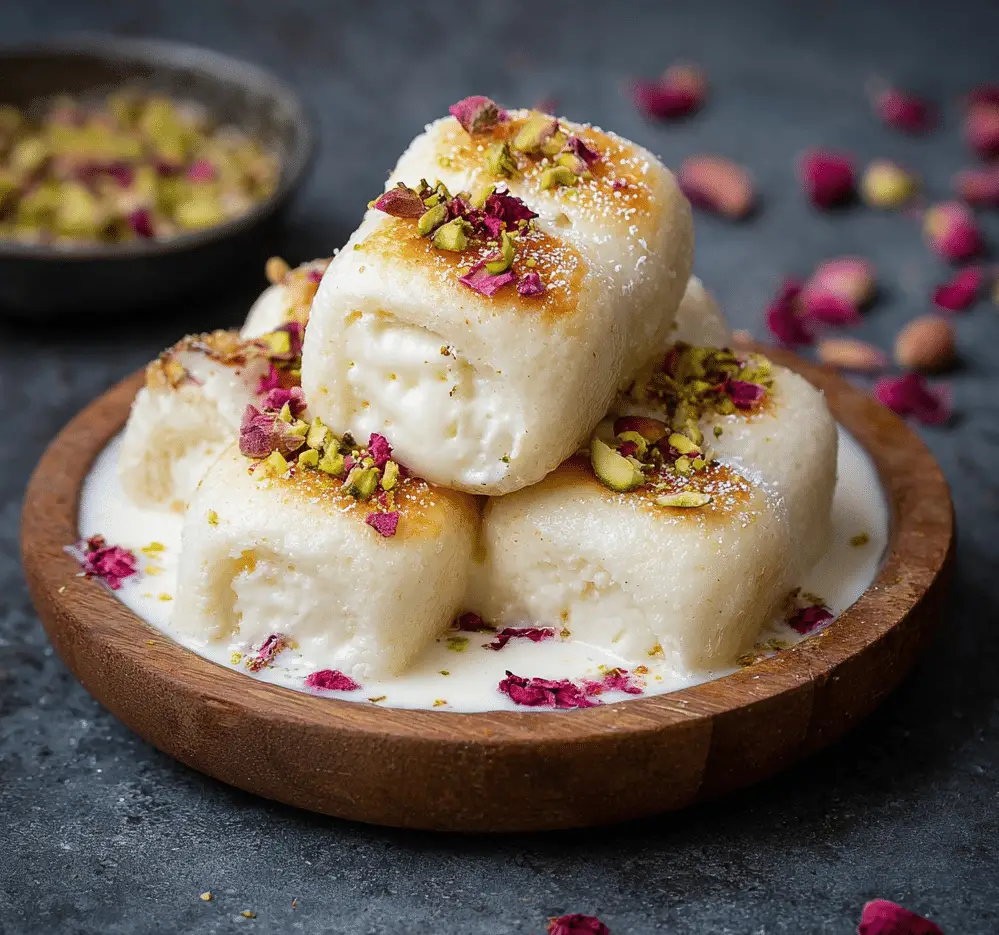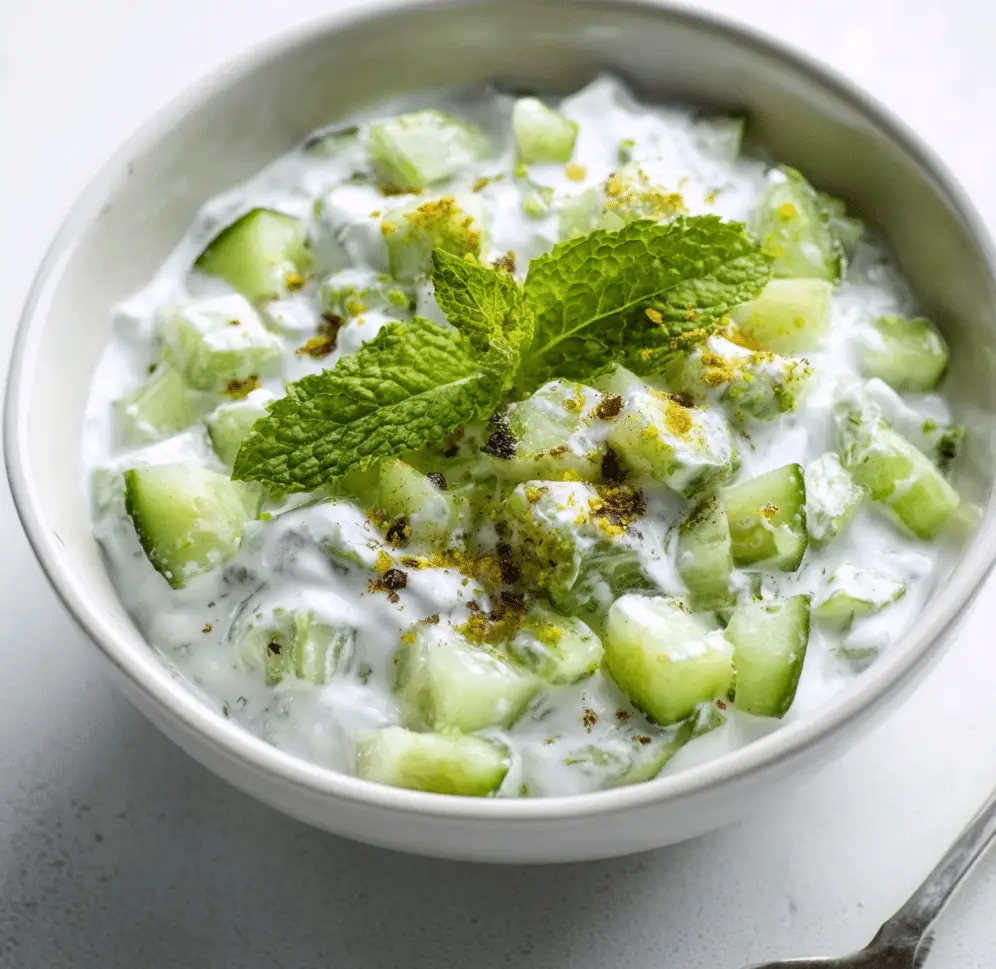These beef kofta kebabs are a celebration of bold Middle Eastern flavors fused with a Greek-inspired twist. Ground beef is gently seasoned with aromatic spices—cumin, coriander, smoked paprika, and a hint of cinnamon—then formed onto skewers and grilled until perfectly charred and juicy. Each bite bursts with herbs and warmth, evoking memories of sun-soaked Mediterranean evenings.
Pairing these skewers with a cooling tzatziki sauce brings balance to the dish. The creamy yogurt, tangy lemon, fresh dill, and crisp cucumber create a refreshing contrast to the richness of the meat. Whether for a casual family dinner or a summer gathering with friends, this dish is simple to prepare yet impressive in flavor—ultimate comfort food with a fresh twist.
Full Recipe
Ingredients:
-
1 lb (450 g) ground beef (preferably 80/20)
-
1 small onion, finely grated
-
2 cloves garlic, minced
-
2 Tbsp fresh parsley, chopped
-
1 Tbsp fresh mint, chopped
-
1 tsp ground cumin
-
1 tsp ground coriander
-
½ tsp smoked paprika
-
¼ tsp ground cinnamon
-
Salt and pepper, to taste
-
6–8 metal or soaked wooden skewers
Tzatziki Sauce:
-
1 cup Greek yogurt
-
½ cucumber, seeded and finely grated
-
1 clove garlic, minced
-
1 Tbsp fresh dill, chopped
-
1 Tbsp lemon juice
-
Salt and pepper, to taste
Directions:
-
In a large bowl, combine beef, onion, garlic, parsley, mint, cumin, coriander, paprika, cinnamon, salt, and pepper. Mix gently until evenly combined.
-
Divide mixture into 6–8 equal portions and carefully shape onto skewers, pressing to form long sausage-like kebabs.
-
Preheat grill or grill pan to medium-high heat. Lightly oil grates.
-
Grill kebabs for 10–12 minutes, turning occasionally until charred in spots and cooked through (internal temp ~160 °F / 71 °C).
-
Meanwhile, prepare tzatziki: squeeze excess water from grated cucumber using a kitchen towel. In a bowl, mix cucumber, yogurt, garlic, dill, lemon juice, salt, and pepper. Chill until ready to serve.
-
Serve kebabs hot with tzatziki sauce on the side.
Prep Time: 15 min | Cooking Time: 12 min | Total Time: 27 min | Kcal: ~350 kcal per serving | Servings: 4
Origins of Beef Kofta Kebabs
Beef kofta kebabs trace their roots back to Middle Eastern and South Asian cuisines, where “kofta” generally refers to ground meat mixed with spices and herbs, then shaped into meatballs or elongated forms. The term “kofta” itself is derived from the Persian word kuftan, which means “to grind.” This reflects the traditional practice of finely mincing meat to create a smooth, cohesive mixture that absorbs spices deeply. Over centuries, kofta recipes have spread and evolved throughout the Mediterranean, Central Asia, the Balkans, and beyond—each region putting its unique spin on the beloved meat dish. In the Levant, koftas are often grilled as kebabs and served with refreshing sides like yogurt-based dips, rice, or flatbreads.
Beef kofta kebabs, specifically, are a hearty and flavorful variation that is especially popular in Lebanon, Turkey, Greece, and North Africa. While lamb is commonly used in traditional versions, beef has become a widely accepted substitute due to its availability and leaner profile. These kebabs offer a delicious balance of savory spices and grilled smokiness, making them a favorite for weeknight dinners and festive cookouts alike.
The Role of Spices and Herbs
The magic of beef kofta lies in the intricate blend of spices and fresh herbs that flavor the ground meat. This isn’t just about heat or pungency—it’s about building a complex aroma and richness that elevates simple ingredients into something extraordinary. Key spices like cumin and coriander deliver warmth and depth, while paprika adds a subtle smokiness and visual appeal. A touch of ground cinnamon provides an unexpected sweetness that balances the boldness of the meat. Fresh parsley and mint add brightness and herbaceous notes that cut through the richness, enhancing the overall harmony of the dish.
Using fresh herbs is essential; they don’t just flavor the meat but also act as natural tenderizers and visual enhancements. The balance between earthy spices and vibrant herbs is what gives beef kofta its signature taste profile: bold, yet refreshing.
Texture and Technique
Achieving the perfect texture for kofta kebabs is an art. The meat mixture should be moist but firm enough to cling to the skewer without falling apart on the grill. This requires careful mixing—overmixing can make the kebabs tough, while undermixing might cause them to crumble. Grated onion plays a crucial role, not only adding flavor but also acting as a binding agent by releasing moisture and natural sugars.
Shaping the koftas evenly around skewers ensures consistent cooking. Whether you use metal or wooden skewers (always soak wooden ones to prevent burning), the shape and uniformity help create that iconic “kebab” look while allowing the meat to sear evenly. A medium-high grill or grill pan is ideal to achieve the coveted outer char while keeping the inside juicy and tender.
Pairing with Tzatziki
While the koftas deliver bold, meaty flavors, pairing them with tzatziki brings balance and freshness to the dish. Tzatziki, a traditional Greek dip made with strained yogurt, grated cucumber, garlic, lemon juice, and dill, complements the spicy kebabs perfectly. It’s cool, tangy, and creamy—everything you want to contrast the charred exterior and rich interior of the meat.
The interplay between hot and cold, spiced and creamy, makes this combo particularly satisfying. Not only does the tzatziki refresh the palate, but it also elevates the dish into something more vibrant and rounded. You’ll often find beef kofta and tzatziki served together in wraps, rice bowls, or mezze platters for a complete and balanced meal.
Nutritional Highlights
Beef kofta kebabs are surprisingly nutritious for such a satisfying dish. They’re protein-rich and packed with micronutrients like zinc, iron, and B-vitamins from the beef. Using lean ground beef (such as 80/20 or 85/15) ensures a good balance between moisture and healthfulness. The spices and herbs add antioxidants and anti-inflammatory benefits, while the yogurt in tzatziki provides probiotics that are excellent for gut health.
This meal is naturally low in carbohydrates and can easily be made gluten-free and keto-friendly. For those seeking higher fiber content, pairing the koftas with a side of grilled vegetables, chickpea salad, or a whole grain like quinoa makes the dish even more complete.
Meal Versatility
One of the best aspects of this recipe is how adaptable it is. The beef kofta mixture can be shaped into meatballs, patties, or even sliders for a creative spin. You can bake them in the oven, pan-fry them, or air-fry for a quicker, less oily version. For presentation, consider skewering cherry tomatoes, bell pepper chunks, or onions in between the koftas to create colorful kebab platters.
The dish pairs beautifully with a wide range of sides—from flatbreads like pita or naan to refreshing sides like tabbouleh, cucumber salad, or lemony couscous. For an elegant dinner, serve the kebabs over a bed of saffron rice with a drizzle of olive oil and lemon zest.
Cultural Significance
Beef kofta kebabs are more than just a flavorful dish—they’re a symbol of shared heritage, communal dining, and cultural richness. In many Mediterranean and Middle Eastern households, kofta is a staple at celebrations, family gatherings, and holiday feasts. Each family may have its own secret spice mix or special method of preparation, making it a dish filled with memory and tradition.
Whether grilled outdoors over charcoal or pan-seared indoors during winter, kofta brings people together around the table. It’s a versatile canvas for experimentation and personalization, while still honoring the authenticity of its roots.
Serving Suggestions and Presentation
Presentation matters with a dish as visually appealing as beef kofta kebabs. Serve them directly on the skewers for a rustic, communal feel, or slide them off onto individual plates with generous dollops of tzatziki. Garnish with chopped fresh herbs, a drizzle of olive oil, or a sprinkle of sumac for added flair and color. Lemon wedges on the side enhance the brightness of the entire plate.
To elevate the experience further, consider serving the koftas with pickled onions, fresh cherry tomatoes, and warm flatbreads for build-your-own wraps. This interactive style of serving encourages guests to create their own perfect bite and adds fun to any gathering.
Storage and Leftovers
Beef kofta kebabs store well and taste just as delicious the next day. Refrigerate any leftovers in an airtight container for up to three days. You can reheat them in a skillet or oven, or even chop them into a salad or rice bowl for a quick lunch. Tzatziki sauce also keeps well for 2–3 days and can double as a dip for veggies, crackers, or grilled chicken.
For meal prep, you can shape and freeze the raw kofta mixture in advance. Thaw and grill as needed for a fresh meal anytime. This makes kofta a convenient and flavorful option for busy weeknights or impromptu gatherings.
Conclusion
Beef kofta kebabs with tzatziki offer a vibrant and satisfying dining experience that bridges cultures and brings bold flavors to your table. From the richly spiced meat to the refreshing yogurt sauce, every bite is a harmony of textures, temperatures, and tastes. This recipe is proof that wholesome meals don’t need to be complicated—just thoughtfully seasoned and beautifully paired.
Whether you’re grilling outdoors with friends or preparing a cozy dinner at home, this dish stands out for its simplicity, nutrition, and crowd-pleasing appeal. It’s a timeless favorite that invites variation and personalization, while remaining grounded in tradition. Once you try it, it’s bound to become a staple in your kitchen too.








